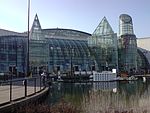Greenhithe railway station
1849 establishments in EnglandDfT Category E stationsFormer South Eastern Railway (UK) stationsGreenhitheKent railway station stubs ... and 6 more
Railway stations in Great Britain opened in 1849Railway stations in KentRailway stations served by Govia Thameslink RailwayRailway stations served by SoutheasternTransport in the Borough of DartfordUse British English from August 2015

Greenhithe railway station (also known as Greenhithe for Bluewater) serves the village of Greenhithe in north Kent and Bluewater Shopping Centre. It is 19 miles 69 chains (32.0 km) down the line from London Charing Cross. Train services are operated by Southeastern and Thameslink.
Excerpt from the Wikipedia article Greenhithe railway station (License: CC BY-SA 3.0, Authors, Images).Greenhithe railway station
Station Road,
Geographical coordinates (GPS) Address Nearby Places Show on map
Geographical coordinates (GPS)
| Latitude | Longitude |
|---|---|
| N 51.450636111111 ° | E 0.27898055555556 ° |
Address
Station Road
DA9 9RE , Swanscombe and Greenhithe
England, United Kingdom
Open on Google Maps








